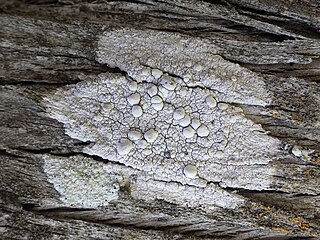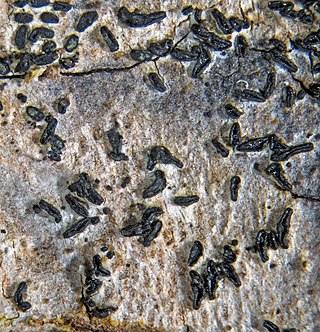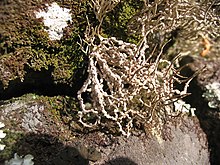
The Arthoniales is the second largest order of mainly crustose lichens, but fruticose lichens are present as well. The order contains around 1500 species, while the largest order with lichenized fungi, the Lecanorales, contains more than 14000 species.

The Arthoniaceae are a family of lichenized, lichenicolous and saprobic fungi in the order Arthoniales. The Arthoniaceae is the largest family of Arthoniales, with around 800 species. Most species in Arthoniaceae belong in Arthonia which is the largest genus with 500 species. The second and third largest genus is Arthothelium with 80 species, and Cryptothecia with 60 species.

Chiodecton is a genus of lichens in the family Roccellaceae. The genus was circumscribed by lichenologist Erik Acharius in 1814, with Chiodecton sphaerale assigned as the type species.

Enterographa is a genus of lichens in the family Roccellaceae.

Dirina is a genus of lichen-forming fungi in the family Roccellaceae. All Dirina species are crustose lichens with a whitish to greyish brown thallus, and live either on rock or on bark–some species can live on both. The photobiont partner is a member of the green algal genus Trentepohlia. Most species occur in the Northern Hemisphere, and are generally restricted to coastal habitats, where they may be locally quite common. Erythrin and lecanoric acid are lichen products that usually occur in Dirina species, along with several other unidentified substances.

Lecanographa is a genus of about 40 species of lichens in the family Lecanographaceae. It was circumscribed in 1994 by José M. Egea and Pilar Torrente, with Lecanographa lyncea as the type species.

Lecanactis is a genus of crustose lichens, commonly called old wood rimmed lichen. The genus was circumscribed in 1855 by German lichenologist Gustav Wilhelm Körber, who assigned Lecanactis abietina as the type species.

Roccella is a genus of 23 species of lichens in the family Roccellaceae. The genus was circumscribed by Swiss botanist Augustin Pyramus de Candolle in 1805, with Roccella fuciformis as the type species.
Tania is a genus of lichenized fungi in the family Roccellaceae. It has two species. The genus was circumscribed by Maria Egea Fernández, Pilar Torrente and Harrie Sipman in 1995, with Tania lanosa assigned as the type, and at that time, only species. A second species, T. mohamedii, was added to the genus in 2006. The genus name honours bryologist Benito Ching Tan (1946–2016), who organized the expedition to Mount Kinabalu and collected the type species with Sipman.

Alyxoria is a genus of lichen-forming fungi in the family Lecanographaceae.

Opegraphaceae is a family of lichen-forming and lichenicolous fungi in the order Arthoniales. It was originally proposed by German lichenologist Ernst Stizenberger in 1862. It fell into disuse, but was resurrected in a molecular phylogenetic study of the order Arthoniales published in 2010. It now includes taxa that were previously referred to the family Roccellaceae, its sister group.
Crocellina is a monotypic fungal genus in the family Roccellaceae. It contains the single species Crocellina cinerea, a saxicolous (rock-dwelling), crustose lichen that is endemic to Socotra Island in the Indian Ocean. This species was first described in 1882 by Swiss botanist Johannes Müller Argoviensis as Dirina cinerea, and later transferred to genus Roccellina in 1983. Crocellina was circumscribed in 2014 by Anders Tehler and Damien Ernst, following molecular phylogenetic analysis and revision of the Roccellaceae.
Vigneronia is a genus of lichen-forming fungi in the family Roccellaceae. It has five species. The genus was circumscribed in 2014 by Damien Ernst, with Vigneronia spieri assigned as the type species. This species, originally described as Schismatomma spieri from collections made in the Galápagos Islands, has since been recorded from mainland Ecuador and the Antilles (Curaçao). The genus is named after Ernst's wife, Nathalie Vigneron, who accompanied him on collecting trips.
Psoronactis is a monotypic fungal genus in the family Roccellaceae. It contains the single species Psoronactis dilleniana, a saxicolous (rock-dwelling), crustose lichen. This species was first described in 1799 by Swedish lichenologist Erik Acharius as Lichen dillenianus. The taxon was shuffled to several genera in the 1800s as different authors had different opinions on how to classify the species; in more modern times, it was transferred to genus Lecanographa in 2013. Psoronactis was circumscribed in 2014 by Damien Ernst and Anders Tehler, following molecular phylogenetic analysis and revision of the Roccellaceae that showed the species occupied a distinct lineage in the family. The genus name alludes to the lichen products present in its thallus: psoromic acid and 2'-O-demethylpsoromic acid. It is these compounds that differentiate it chemically from the similar genus Lecanactis.
Diromma is a monotypic fungal genus in the family Roccellaceae. It contains the single species Diromma dirinellum, a rare crustose lichen that grows as a parasite on the lichen Dirina ceratoniae. It has a distribution restricted to the Mediterranean Basin.

Pseudoschismatomma is a monotypic fungal genus in the family Roccellaceae. It contains the single species Pseudoschismatomma rufescens, a corticolous (bark-dwelling), crustose lichen. This species was first described in 1794 by Christiaan Hendrik Persoon as Opegrapha rufescens. Pseudoschismatomma was circumscribed in 2014 by Damien Ernst and Anders Tehler, following molecular phylogenetic analysis and revision of the Roccellaceae. The genus name alludes to its similarity with genus Schismatomma, particularly S. graphidioides. It differs from this species in having a distinct brown true exciple.
Ocellomma is a genus of lichen-forming fungi in the family Roccellaceae. The genus was circumscribed in 2014 by Damien Ertz and Anders Tehler, following a molecular phylogenetic-based revision of the Roccellaceae. The type species, O. picconianum, was originally named Lecania picconiana by Francesco Baglietto in 1862, described from specimens collected in Italy. DNA-based phylogenetic analysis showed that it occupied a distinct genetic lineage, deserving of recognition as a new genus. The genus name Ocellomma alludes to the whitish rims on the small ascomata that contrast with the discs, giving them the appearance of small eyes.
Dirina candida is a species of saxicolous (rock-dwelling), crustose lichen in the family Roccellaceae. It is found in the southern Mediterranean Basin, with a range extending east to Egypt and Libya. It grows on calcareous rocks that are close to the sea. The lichen was formally described as a new species in 1885 by Johannes Müller Argoviensis from specimens collected in Alexandria, Egypt. Anders Teher and Damien Ertz transferred it to Dirina in 2013. Tehler had previously (1983) referred this species to Dirina immersa, but later molecular phylogenetic analysis revealed that it should instead be considered a distinct species, despite the two sharing the same appearance, morphology, and chemistry.
Vigneronia spieri is a species of corticolous (bark-dwelling), crustose lichen in the family Roccellaceae. It is found in the Galápagos Islands, mainland Ecuador and the Antilles (Curaçao).

Fulvophyton is a genus of lichen-forming fungi in the family Roccellographaceae. It has 11 species. Fulvophyton is characterised by its crust-like thallus, which is often pale yellowish-brown in colour. This genus features a photobiont from the green algal genus Trentepohlia and exhibits a unique arrangement of reproductive structures.












